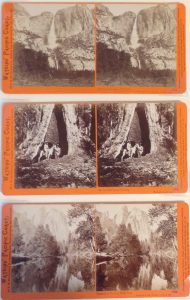
![]() In July 1861, San Francisco photographer Carleton Watkins made the first of many trips to remote Yosemite Valley with a mammoth plate camera, equipped for 18 x 22 inch glass plate negatives, and a stereoscopic camera. He returned with thirty mammoth plates and around a hundred stereograph negatives. By 1863, Watkins was selling stereographs of Yosemite, as well as other sites of interest around San Francisco. In June 1864, his stunning photographs of Yosemite’s peaks and valleys were instrumental in helping to convince President Abraham Lincoln and the 38th U.S. Congress to pass the Yosemite Valley Grant Act, which preserved the land for public use and set the pattern for the National Park System that would follow.
In July 1861, San Francisco photographer Carleton Watkins made the first of many trips to remote Yosemite Valley with a mammoth plate camera, equipped for 18 x 22 inch glass plate negatives, and a stereoscopic camera. He returned with thirty mammoth plates and around a hundred stereograph negatives. By 1863, Watkins was selling stereographs of Yosemite, as well as other sites of interest around San Francisco. In June 1864, his stunning photographs of Yosemite’s peaks and valleys were instrumental in helping to convince President Abraham Lincoln and the 38th U.S. Congress to pass the Yosemite Valley Grant Act, which preserved the land for public use and set the pattern for the National Park System that would follow.
In 1871 Watkins moved to larger quarters in San Francisco and opened his Yosemite Art Gallery. There he displayed mammoth plate photographs and more than a thousand stereographs. Stereographs printed with Watkins’ 22-26 Montgomery Street address date from the period between Watkins’ move to larger quarters in 1871 and the loss of his gallery and negatives due to financial pressures in 1875.![]()
The mountains and waterfalls of Yosemite were favorite subjects for Watkins’ cameras. His earliest views of waterfalls, like this one, focused on the falls themselves. When he returned in 1864 and 1865 to make photographs for the California State Geological Survey, he used a new wide-angle lens to provide broader views from a more distant location.
Watkins made a number of photographs of the massive sequoia trees of the Mariposa Grove. The figure on horseback posing here may be Galen Clark, one of the first white settlers in Yosemite and the caretaker of the trees. Back East, viewers were amazed by photographic documents of the enormous trees. Ralph Waldo Emerson declared that Watkins’ photographs of the tree known as the Grizzly Giant “made the trees possible.”![]()
Early visitors to Yosemite envisioned the massive geological features in religious terms. By naming a towering granite face Cathedral Rock, a direct association was drawn between the medieval cathedrals of Europe and the natural cathedrals of the New World. Like Ansel Adams’ photograph of Lower Paradise Valley, the notion that the divine could be found within the beauties of nature is evident in the anglicized names of Yosemite sites that replaced Native American ones.